Abstract
The biological effects of staphylococcal enterotoxins (SE), potentiated by bacterial lipopolysaccharide (LPS), were studied with mice. Control animals survived the maximum dose of either SE or LPS, while mice receiving both agents died. SEA was 43-fold more potent than SEB and 20-fold more potent than SEC1. The mechanism of toxicity was further examined with transgenic mice deficient in major histocompatibility complex class I or II expression. Class II-deficient mice were resistant to SEA or SEB. However, class I-deficient animals were less susceptible to SEA (30% lethality) than wild-type mice (93% lethality). In vitro stimulation of T cells from the three mouse phenotypes by SEA correlated well with toxicity. T cells from transgenic or wild-type mice were similarly responsive to SEA when presented by irradiated, wild-type mononuclear cells. These data confirmed that the toxicity of SE was mainly exerted through a mechanism dependent on the expression of major histocompatibility complex class II molecules. Toxicity was also linked to stimulated cytokine release. Levels in serum of tumor necrosis factor alpha, interleukin-6, and gamma interferon peaked 2 to 4 h after the potentiating dose of LPS but returned to normal within 10 h. Concentrations of interleukin-1 alpha were also maximal after 2 h but remained above the background for up to 22 h. Relative to the levels in mice given only SEA or LPS, the levels in serum of tumor necrosis factor alpha, interleukin-6, and gamma interferon increased 5-, 10-, and 15-fold, respectively, after injections of SEA plus LPS. There was only an additive effect of SEA and LPS on interleukin-1 alpha concentrations.
Full text
PDF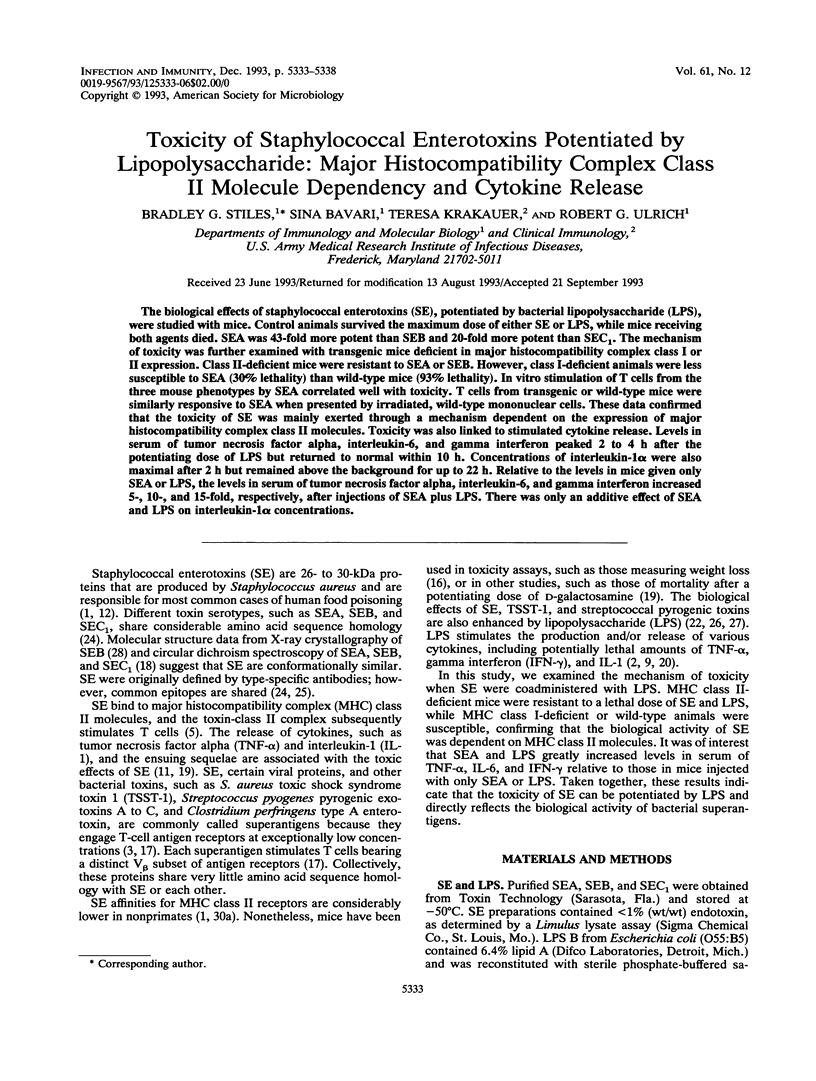
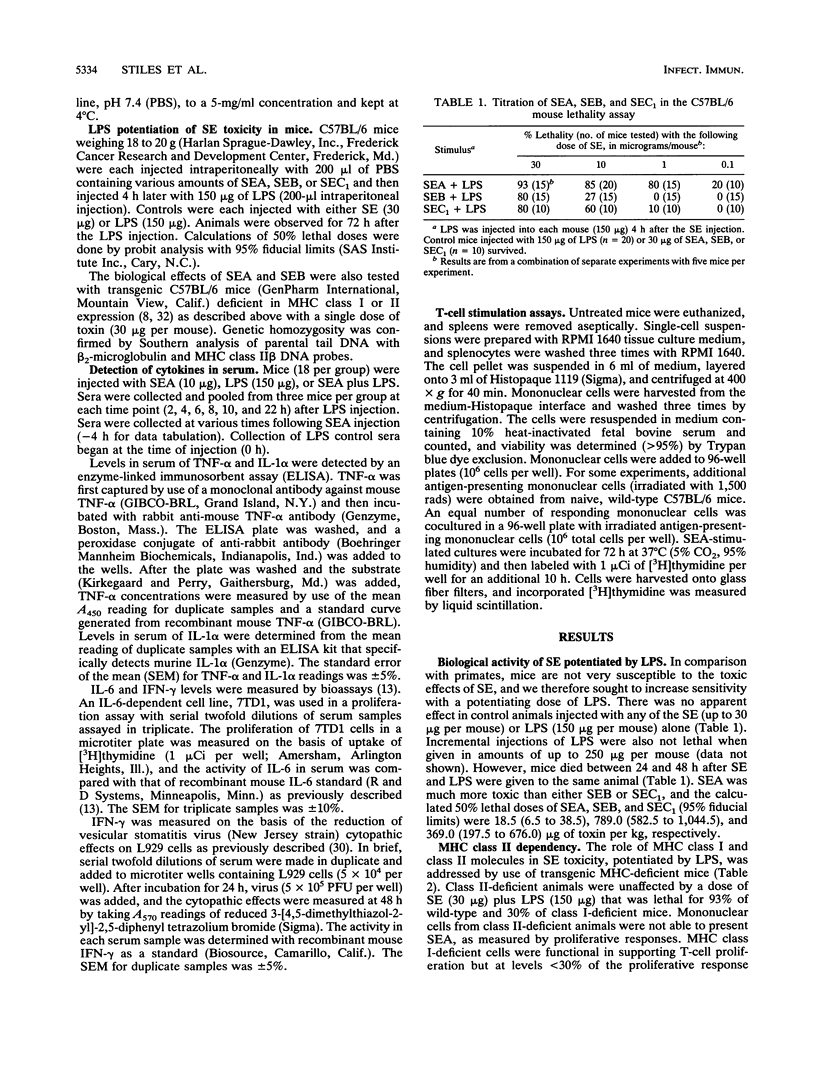
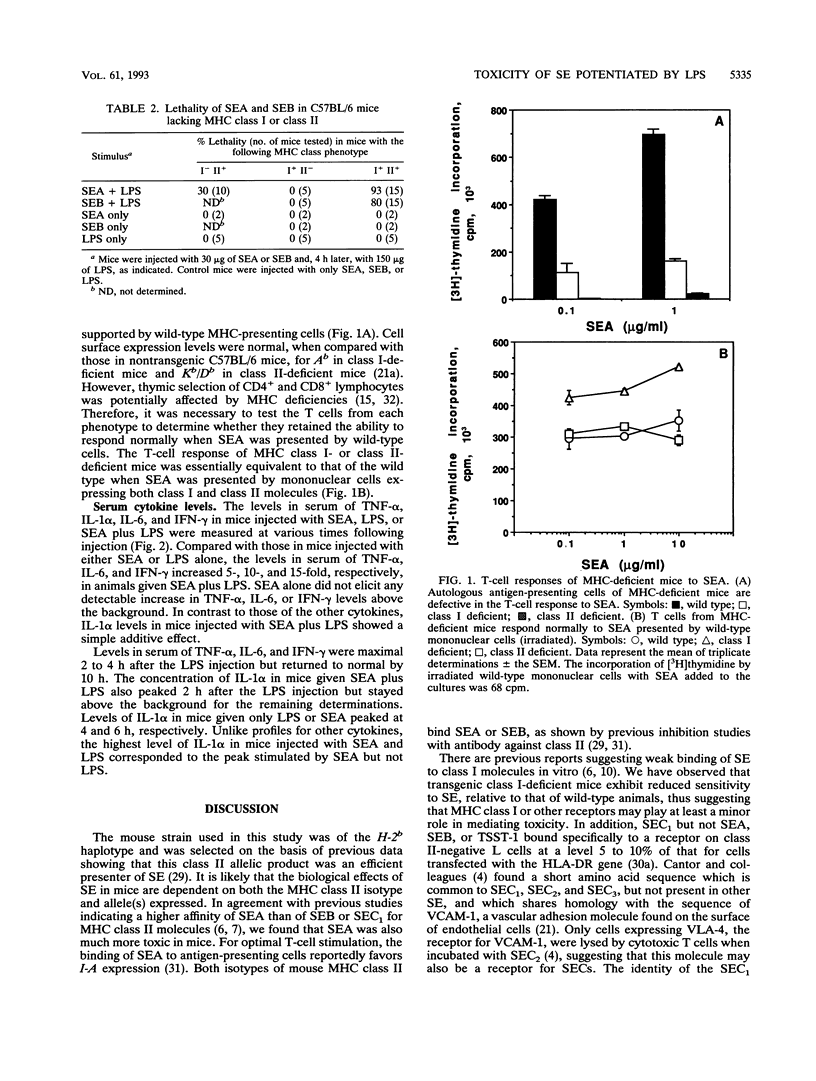
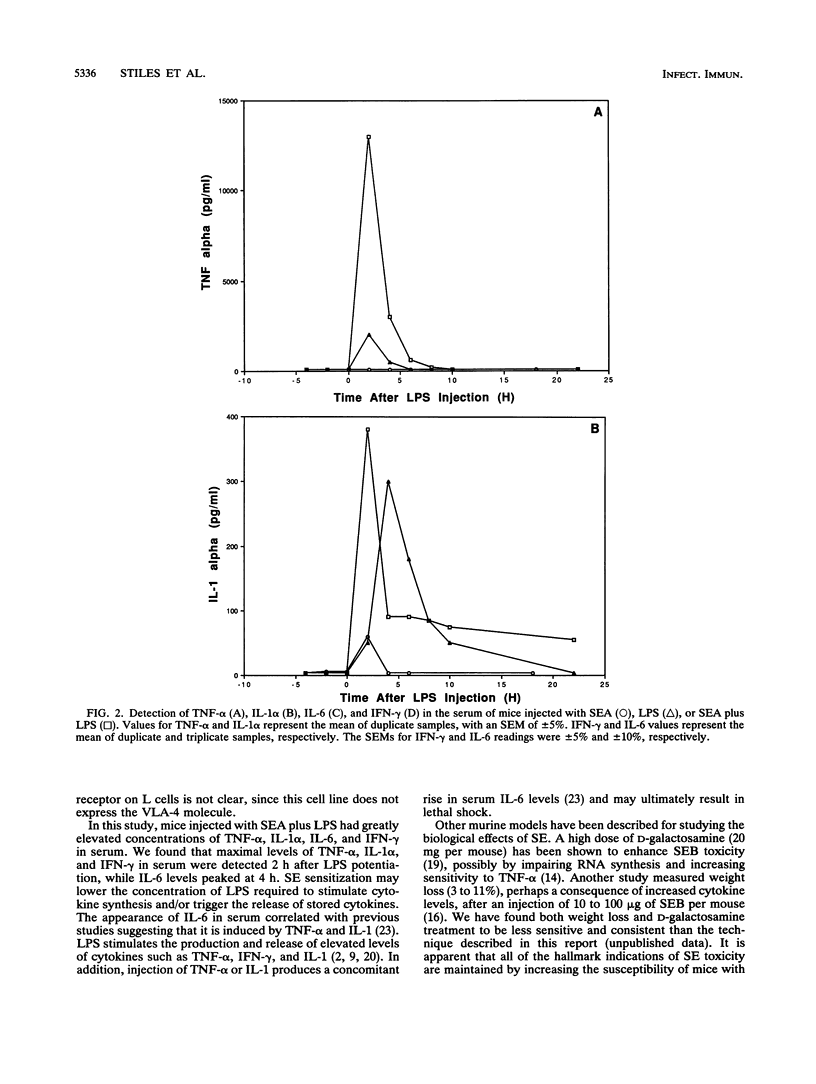
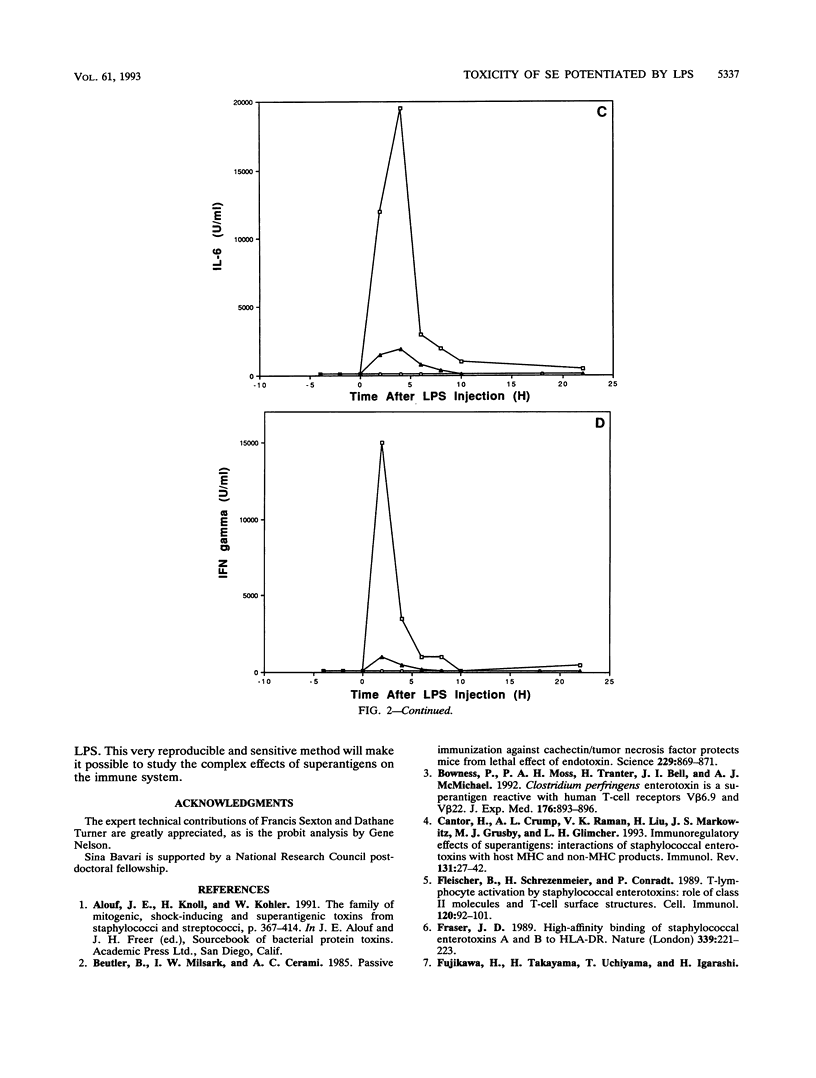
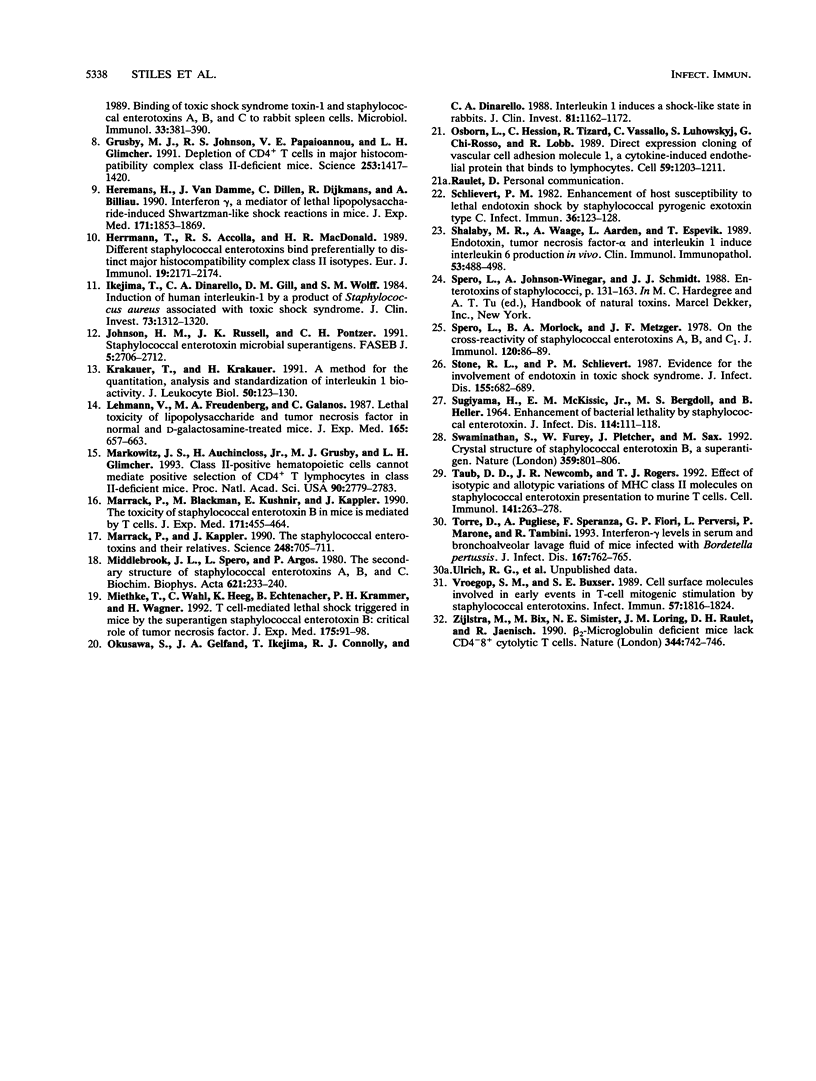
Selected References
These references are in PubMed. This may not be the complete list of references from this article.
- Beutler B., Milsark I. W., Cerami A. C. Passive immunization against cachectin/tumor necrosis factor protects mice from lethal effect of endotoxin. Science. 1985 Aug 30;229(4716):869–871. doi: 10.1126/science.3895437. [DOI] [PubMed] [Google Scholar]
- Bowness P., Moss P. A., Tranter H., Bell J. I., McMichael A. J. Clostridium perfringens enterotoxin is a superantigen reactive with human T cell receptors V beta 6.9 and V beta 22. J Exp Med. 1992 Sep 1;176(3):893–896. doi: 10.1084/jem.176.3.893. [DOI] [PMC free article] [PubMed] [Google Scholar]
- Cantor H., Crump A. L., Raman V. K., Liu H., Markowitz J. S., Grusby M. J., Glimcher L. H. Immunoregulatory effects of superantigens: interactions of staphylococcal enterotoxins with host MHC and non-MHC products. Immunol Rev. 1993 Feb;131:27–42. doi: 10.1111/j.1600-065x.1993.tb01528.x. [DOI] [PubMed] [Google Scholar]
- Fleischer B., Schrezenmeier H., Conradt P. T lymphocyte activation by staphylococcal enterotoxins: role of class II molecules and T cell surface structures. Cell Immunol. 1989 Apr 15;120(1):92–101. doi: 10.1016/0008-8749(89)90177-9. [DOI] [PubMed] [Google Scholar]
- Fraser J. D. High-affinity binding of staphylococcal enterotoxins A and B to HLA-DR. Nature. 1989 May 18;339(6221):221–223. doi: 10.1038/339221a0. [DOI] [PubMed] [Google Scholar]
- Fujikawa H., Takayama H., Uchiyama T., Igarashi H. Bindings of toxic shock syndrome toxin-1 and staphylococcal enterotoxins A, B, and C to rabbit spleen cells. Microbiol Immunol. 1989;33(5):381–390. doi: 10.1111/j.1348-0421.1989.tb01986.x. [DOI] [PubMed] [Google Scholar]
- Grusby M. J., Johnson R. S., Papaioannou V. E., Glimcher L. H. Depletion of CD4+ T cells in major histocompatibility complex class II-deficient mice. Science. 1991 Sep 20;253(5026):1417–1420. doi: 10.1126/science.1910207. [DOI] [PubMed] [Google Scholar]
- Heremans H., Van Damme J., Dillen C., Dijkmans R., Billiau A. Interferon gamma, a mediator of lethal lipopolysaccharide-induced Shwartzman-like shock reactions in mice. J Exp Med. 1990 Jun 1;171(6):1853–1869. doi: 10.1084/jem.171.6.1853. [DOI] [PMC free article] [PubMed] [Google Scholar]
- Herrmann T., Accolla R. S., MacDonald H. R. Different staphylococcal enterotoxins bind preferentially to distinct major histocompatibility complex class II isotypes. Eur J Immunol. 1989 Nov;19(11):2171–2174. doi: 10.1002/eji.1830191131. [DOI] [PubMed] [Google Scholar]
- Ikejima T., Dinarello C. A., Gill D. M., Wolff S. M. Induction of human interleukin-1 by a product of Staphylococcus aureus associated with toxic shock syndrome. J Clin Invest. 1984 May;73(5):1312–1320. doi: 10.1172/JCI111334. [DOI] [PMC free article] [PubMed] [Google Scholar]
- Johnson H. M., Russell J. K., Pontzer C. H. Staphylococcal enterotoxin microbial superantigens. FASEB J. 1991 Sep;5(12):2706–2712. doi: 10.1096/fasebj.5.12.1916093. [DOI] [PubMed] [Google Scholar]
- Krakauer T., Krakauer H. A method for the quantitative analysis and standardization of interleukin-1 bioactivity. J Leukoc Biol. 1991 Aug;50(2):123–130. doi: 10.1002/jlb.50.2.123. [DOI] [PubMed] [Google Scholar]
- Lehmann V., Freudenberg M. A., Galanos C. Lethal toxicity of lipopolysaccharide and tumor necrosis factor in normal and D-galactosamine-treated mice. J Exp Med. 1987 Mar 1;165(3):657–663. doi: 10.1084/jem.165.3.657. [DOI] [PMC free article] [PubMed] [Google Scholar]
- Markowitz J. S., Auchincloss H., Jr, Grusby M. J., Glimcher L. H. Class II-positive hematopoietic cells cannot mediate positive selection of CD4+ T lymphocytes in class II-deficient mice. Proc Natl Acad Sci U S A. 1993 Apr 1;90(7):2779–2783. doi: 10.1073/pnas.90.7.2779. [DOI] [PMC free article] [PubMed] [Google Scholar]
- Marrack P., Blackman M., Kushnir E., Kappler J. The toxicity of staphylococcal enterotoxin B in mice is mediated by T cells. J Exp Med. 1990 Feb 1;171(2):455–464. doi: 10.1084/jem.171.2.455. [DOI] [PMC free article] [PubMed] [Google Scholar]
- Marrack P., Kappler J. The staphylococcal enterotoxins and their relatives. Science. 1990 May 11;248(4956):705–711. doi: 10.1126/science.2185544. [DOI] [PubMed] [Google Scholar]
- Middlebrook J. L., Spero L., Argos P. The secondary structure of staphylococcal enterotoxins A, B and C. Biochim Biophys Acta. 1980 Feb 27;621(2):233–240. doi: 10.1016/0005-2795(80)90175-0. [DOI] [PubMed] [Google Scholar]
- Miethke T., Wahl C., Heeg K., Echtenacher B., Krammer P. H., Wagner H. T cell-mediated lethal shock triggered in mice by the superantigen staphylococcal enterotoxin B: critical role of tumor necrosis factor. J Exp Med. 1992 Jan 1;175(1):91–98. doi: 10.1084/jem.175.1.91. [DOI] [PMC free article] [PubMed] [Google Scholar]
- Okusawa S., Gelfand J. A., Ikejima T., Connolly R. J., Dinarello C. A. Interleukin 1 induces a shock-like state in rabbits. Synergism with tumor necrosis factor and the effect of cyclooxygenase inhibition. J Clin Invest. 1988 Apr;81(4):1162–1172. doi: 10.1172/JCI113431. [DOI] [PMC free article] [PubMed] [Google Scholar]
- Osborn L., Hession C., Tizard R., Vassallo C., Luhowskyj S., Chi-Rosso G., Lobb R. Direct expression cloning of vascular cell adhesion molecule 1, a cytokine-induced endothelial protein that binds to lymphocytes. Cell. 1989 Dec 22;59(6):1203–1211. doi: 10.1016/0092-8674(89)90775-7. [DOI] [PubMed] [Google Scholar]
- SUGIYAMA H., MCKISSIC E. M., Jr, BERGDOLL M. S., HELLER B. ENHANCEMENT OF BACTERIAL ENDOTOXIN LETHALITY BY STAPHYLOCOCCAL ENTEROTOXIN. J Infect Dis. 1964 Apr;114:111–118. doi: 10.1093/infdis/114.2.111. [DOI] [PubMed] [Google Scholar]
- Schlievert P. M. Enhancement of host susceptibility to lethal endotoxin shock by staphylococcal pyrogenic exotoxin type C. Infect Immun. 1982 Apr;36(1):123–128. doi: 10.1128/iai.36.1.123-128.1982. [DOI] [PMC free article] [PubMed] [Google Scholar]
- Shalaby M. R., Waage A., Aarden L., Espevik T. Endotoxin, tumor necrosis factor-alpha and interleukin 1 induce interleukin 6 production in vivo. Clin Immunol Immunopathol. 1989 Dec;53(3):488–498. doi: 10.1016/0090-1229(89)90010-x. [DOI] [PubMed] [Google Scholar]
- Spero L., Morlock B. A., Metzger J. F. On the cross-reactivity of staphylococcal enterotoxins A, B, and C. J Immunol. 1978 Jan;120(1):86–89. [PubMed] [Google Scholar]
- Stone R. L., Schlievert P. M. Evidence for the involvement of endotoxin in toxic shock syndrome. J Infect Dis. 1987 Apr;155(4):682–689. doi: 10.1093/infdis/155.4.682. [DOI] [PubMed] [Google Scholar]
- Swaminathan S., Furey W., Pletcher J., Sax M. Crystal structure of staphylococcal enterotoxin B, a superantigen. Nature. 1992 Oct 29;359(6398):801–806. doi: 10.1038/359801a0. [DOI] [PubMed] [Google Scholar]
- Taub D. D., Newcomb J. R., Rogers T. J. Effect of isotypic and allotypic variations of MHC class II molecules on staphylococcal enterotoxin presentation to murine T cells. Cell Immunol. 1992 May;141(2):263–278. doi: 10.1016/0008-8749(92)90147-h. [DOI] [PubMed] [Google Scholar]
- Torre D., Pugliese A., Speranza F., Fiori G. P., Perversi L., Marone P., Tambini R. Interferon-gamma levels in serum and bronchoalveolar lavage fluid of mice infected with Bordetella pertussis. J Infect Dis. 1993 Mar;167(3):762–765. doi: 10.1093/infdis/167.3.762. [DOI] [PubMed] [Google Scholar]
- Vroegop S. M., Buxser S. E. Cell surface molecules involved in early events in T-cell mitogenic stimulation by staphylococcal enterotoxins. Infect Immun. 1989 Jun;57(6):1816–1824. doi: 10.1128/iai.57.6.1816-1824.1989. [DOI] [PMC free article] [PubMed] [Google Scholar]
- Zijlstra M., Bix M., Simister N. E., Loring J. M., Raulet D. H., Jaenisch R. Beta 2-microglobulin deficient mice lack CD4-8+ cytolytic T cells. Nature. 1990 Apr 19;344(6268):742–746. doi: 10.1038/344742a0. [DOI] [PubMed] [Google Scholar]


